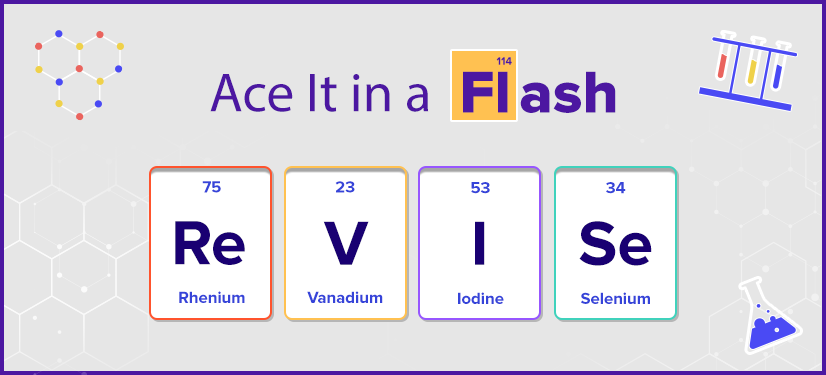Flashcards for Students: What, Why & How?

Flashcard
n. A card that contains a small amount of crucial information — used as a learning aid by students and teachers.
Flashcards are learning tools that operate on the question and answer format. These are small cards, the size of a post-it notes, used for testing your knowledge of a concept/formula/language.
Flashcards for students typically have two sides. A prompt/question on one side and the answer on the other side. Students can use flashcards to learn names, concepts, procedures, chemical reactions, formulae, and more. Flashcards, besides being great learning tools, are also known to boost memory. In the day and age of short attention spans, flashcards are a boon when it comes to memory retention, here’s why:
Based on the Principle of Active Recall
When you learn using this technique, you’re trying to recall the response to a prompt. If your card has H2SO4 written on one side, then you’re trying to recall the name for the molecular formula given here. When you’re unable to recall, you flip the card and read Sulphuric acid. Suffice it to say that revising with flashcards makes sure that you indulge in active learning and not passive reading of your notes.
Furthermore, studies have found that practising active recall helps your brain make stronger neural connections and improve your memory. Not just that, once you flip the flashcard and view the answer, the first thing you do is think about the answer in your head before you saw the other side and compare it with this one.
This process, known as metacognition, is an effective way to retain information. It allows you to reflect and alter your thought processes to make them more accurate.
Operate on Spaced Repetition
When you’re revising concepts using flashcards you categorise your cards based on if ‘you know’ or ‘do not know’ the answer. This means that you return to the ‘do not know’ stack many times till you have learned the topic effectively. Studies tell us that, spaced repetition is one of the most effective ways to learn and remember details. Here, your brain sees the information multiple times at different time intervals. This is precisely what helps the brain strengthen its ability to recall information. Now, this method may appear cumbersome but it is certainly effective.

Image via Freepik
How To Make Flashcards for Studying?
Before we delve into the craft, you need to know that you don’t have to make your own flashcards – although we recommend you do because that would help you learn and retain the concepts better. There are many sites online and platforms such as Canva that will help you create visual flashcards. That said, below are some tips to design and learn with flashcards.
- The first step is to know what kind of flashcard works best for you. It can be a simple version with a prompt on one side and a response on the other. You can opt for the ones that are a combination of images and text.
- The next step is to cut out your own cards using chart paper or print out templates after designing them online.
- Categorise the cards under various sections such as definitions, formulae, equations, etc and stack them accordingly. Hint: include short answer type questions here.
- Finally, add a personalised touch to the cards. Include doodles, images, and cues that trigger your memory and help you recall better.
Tips To Revise Using Flashcards
- Look at the prompt first on side A and try recalling the information associated with it without peeking at side B. If it’s something you cannot recall easily, revisit the card after some time for a few intervals of time.
- Ensure you ask questions about the card you are looking at – such as why the information is useful and where you would apply it.
- Reshuffle your flashcards while revising and group them according to themes. This method is known as chunking and is an effective way to recall information.
- Arrange your cards in the form of a mindmap using a piece of yarn to remember information that is interconnected.
- If you are studying with a group – you can make flashcards under different concepts and recall information with help of a game as a group. Hint: use topics that are best suited for flashcards – definitions, formulae, facts, etc.
Flashcards are an effective way to revise difficult topics and a good way to train your brain to recall crucial exam-related concepts. They are easy to access or design online if you prefer digital flashcards. However, we recommend that you make your own using a pen and paper because this will help you write down and recall the facts you need to remember. Try this learning tool and get, set, ace it!
Also read: Exam Tips: How To Get the Right Mindset To Ace Your Paper
Exam Day Tips — Helpful Routines to Follow
Frequently Asked Questions
1. Are flashcards an effective way to study?
Flashcards are an effective self-testing approach. The process of making flashcards allows students to understand and memorise concepts. In addition, the condensed information on flashcards make them a great tool for revisions.
2. Pictures can boost information recall and hence are recommended while making flashcards?
The process of making physical flashcards demands you to write down important concepts by hand, which helps you register and remember concepts far better as opposed to typing it online.
3. Why should you use pictures in a flashcard?
Pictures boost information recall and hence are recommended to make flashcards effective